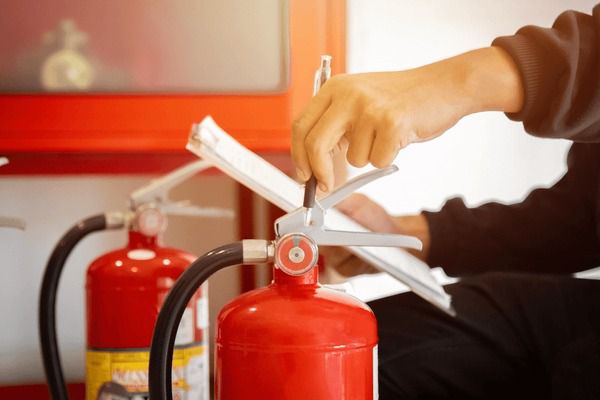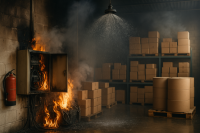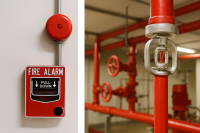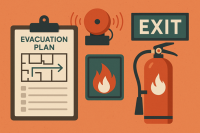
Fire suppression systems are vital components of building safety that play a key role in controlling or extinguishing fires before they spread out of control. These systems are designed to protect both lives and property by automatically or manually releasing fire-suppressing agents when a fire is detected. With various types of fire suppression systems available, each suited for different environments and fire risks, understanding how they work and their benefits is crucial for ensuring comprehensive fire safety.
The Importance of Fire Suppression Systems
Fires can escalate rapidly, causing extensive damage and threatening lives in a matter of minutes. While fire detection systems provide early warnings, suppression systems take the next critical step by directly addressing the fire. When integrated with detection systems, fire suppression systems can activate automatically to contain the blaze, often before it has a chance to spread.
For high-risk environments, such as commercial kitchens, server rooms, or chemical storage facilities, fire suppression systems are essential for minimizing damage and ensuring that fire hazards are addressed immediately. These systems not only help reduce the impact of fire but can also prevent explosions and other secondary hazards that fires may cause.
Types of Fire Suppression Systems
There are several types of fire suppression systems, each designed to combat different kinds of fires depending on the specific hazards in a given environment. The four most common types are water-based, chemical-based, inert gas, and foam fire suppression systems.
- Water-Based Fire Suppression Systems
Water-based fire suppression systems are among the most widely used in buildings, particularly in commercial and residential settings. These systems use water to extinguish fires and can be highly effective against common Class A fires (fires involving ordinary combustibles such as wood, paper, and fabric).- Sprinkler Systems: Sprinkler systems are the most familiar type of water-based suppression. They activate when the surrounding temperature reaches a certain threshold, releasing water to douse the fire. Sprinkler heads can be installed throughout the building to cover large areas.
- Deluge Systems: Deluge systems are similar to sprinklers but release water from all heads at once when a fire is detected. They are used in high-hazard areas where rapid fire spread is a concern, such as chemical plants or power stations.
- Water Mist Systems: These systems use fine mist instead of large amounts of water. The mist cools the fire and displaces oxygen to suppress it. Water mist systems are highly effective in areas where water damage could be a concern, such as data centers or museums.
- Chemical-Based Fire Suppression Systems
Chemical suppression systems release fire-suppressing chemicals to stop the spread of fire. These systems are commonly used in environments where water could cause damage or be ineffective, such as in electrical rooms or industrial kitchens.- Clean Agent Systems: Clean agents are gaseous chemicals (such as FM-200 or Novec 1230) that do not leave residue and are safe for sensitive equipment. They work by interrupting the chemical reaction in the fire, quickly suppressing it without harming the environment or electronics. These systems are typically used in data centers, server rooms, and areas with electrical equipment.
- Wet Chemical Systems: Wet chemical fire suppression systems are commonly used in commercial kitchens. They are designed to combat grease and oil fires (Class K fires) by releasing a chemical agent that reacts with the hot oils to form a foam, cooling the fire and preventing re-ignition.
- Inert Gas Fire Suppression Systems
Inert gas systems work by displacing the oxygen in the room, effectively suffocating the fire. These systems are ideal for spaces where water, foam, or chemical agents might damage equipment or property.- Inert Gas Systems: These systems use gases like nitrogen, argon, or carbon dioxide to reduce the oxygen concentration to levels where fire cannot sustain itself. Because they do not harm equipment, inert gas systems are often used in data centers, server rooms, and archives.
- Carbon Dioxide (CO2) Systems: CO2 systems are highly effective for suppressing fires in enclosed spaces. CO2 gas replaces oxygen in the fire’s vicinity, extinguishing it quickly. However, since CO2 can be hazardous to humans, these systems are only used in unoccupied spaces or with strict safety measures.
- Foam Fire Suppression Systems
Foam fire suppression systems are used to combat fires involving flammable liquids (Class B fires) or materials that may require a blanket to smother the flames. These systems are frequently found in facilities that handle or store large amounts of petroleum, chemicals, or other combustible liquids.- Aqueous Film-Forming Foam (AFFF): AFFF systems create a foam blanket that covers the surface of the flammable liquid, smothering the fire by cutting off its oxygen supply. This type of system is commonly used in aircraft hangars, fuel storage tanks, and chemical plants.
- High Expansion Foam Systems: These systems are particularly useful in confined spaces like engine rooms or warehouses. The foam expands rapidly, filling the area and suppressing the fire by reducing the concentration of oxygen.
Benefits of Fire Suppression Systems
Fire suppression systems provide numerous benefits that make them indispensable for comprehensive fire safety.
- Immediate Response to Fire
Fire suppression systems are designed to activate automatically, ensuring a quick response as soon as a fire is detected. This rapid action can prevent a fire from growing out of control and reduce the time it takes for emergency responders to intervene. - Protection of High-Value Assets
Many suppression systems, particularly those that use clean agents or inert gases, are designed to protect sensitive equipment from fire damage. For businesses with valuable electronic assets or critical infrastructure, these systems offer a dual benefit: fire control without compromising equipment. - Minimizing Property Damage
Water damage from traditional sprinklers can sometimes cause as much damage as the fire itself, particularly in places like offices or data centers. By selecting the appropriate fire suppression system, building owners can significantly reduce the risk of both fire and water damage. - Ensuring Business Continuity
In high-risk environments, a fire could result in costly downtime or even the complete loss of operations. Fire suppression systems not only protect the building and its occupants but also help ensure that businesses can continue functioning after a fire, with minimal disruption. - Compliance with Safety Regulations
Many industries, including manufacturing, healthcare, and hospitality, are required by law to have fire suppression systems in place to protect workers and the public. Complying with these regulations helps businesses avoid penalties and ensures a higher standard of safety for all.
Choosing the Right Fire Suppression System
Selecting the correct fire suppression system depends on the specific fire risks present in a building or facility. For environments with sensitive electronics, such as data centers or telecom rooms, a clean agent or inert gas system is ideal. In commercial kitchens, a wet chemical system is a must to address grease fires. For industrial plants handling hazardous materials, foam suppression systems offer excellent protection against flammable liquids.
Additionally, fire suppression systems must be integrated with fire detection and alarm systems for optimal safety. Regular maintenance and inspections are critical to ensure that these systems function correctly when needed.
Conclusion
Fire suppression systems are vital tools for controlling and extinguishing fires before they can cause significant harm. By choosing the right type of system for specific fire hazards and ensuring they are maintained properly, businesses and property owners can provide robust protection for people, property, and valuable assets.





Leave A Comment